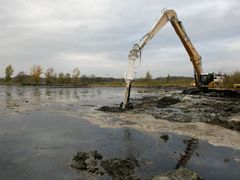Ostrava - Dozens of thousands of tonnes of oil processing refuse currently sitting in large lagoons outside Ostrava will not be burnt in Czech power stations as originally planned, but will be exported to Poland.
Business association Čistá Ostrava (Clean Ostrava) last year won a public order worth almost CZK 3 billion to remove one of the largest environmental damages in the country. Last week they released details of what exactly will happen with the 360 tonnes of this dirty fuel, made by mixing the refinery waste with coal.
"We have a contract with Polish fuel trader E-Carbo, who has informed us that it is reselling our fuel to cement works in Nowiny and Warta in central Poland and to heating plants in Gliwice and Siemianowice [in southern Poland]," said Alena Orlíková, a Čistá Ostrava manager.
She added that most waste from Ostrava lagoons will end up in Poland because the laws there make such a disposal easier than Czech laws. "It is enough if the energy producers observe their emission caps. It is for them to test the technology. In the Czech Republic it's more complicated as buyers have to wait for integrated permits."
Orlíková said that Czech energy companies that had shown interest in buying some of the waste fuel include Elektrárna Dětmarovice, Energetika Třinec and Energetika Zlín. "We estimate that they could get their permits in March or April."
Faster please
Industry and Trade Minister Martin Říman last week paid a visit to the Ostrava lagoons, during which he criticised Čistá Ostrava for being behind the cleanup schedule. The association was originally supposed to produce 40,000 tonnes of fuel by the end of last year.
Instead, it has only produced about 12,000 tonnes, of which about 4,000 tonnes have left for Poland, and trial production will last until February. Full production will only start in April when the project has received all authorizations.
"My feelings are mixed. We may not be able to clean up the lagoons by 2010 as planed," said Říman.
The dirt of the past
The lagoons are located in a former refinery complex in Ostrava, which started dumping its refuse there in the early 20th century. Later the lagoons also served as a dumping place for used up motor oils from all over Czechoslovakia.
Plans to clean up the lagoons have been on the table since the 1990s, but only last year did the waste start to be removed.
Read more: IN PICTURES: See where oil comes to ČR
After the 1989 political turnover the complex was privatised by Ostramo-Vlček. The new owner pledged to remove the waste, but went bankrupt before it could do so. The government then bought the dangerous dump back for CZK 1 and handed them over to the state-run mining firm Diamo.
Čistá Ostrava later won a tender called by Diamo. The association pledged, by 2010, to process some 200,000 tonnes of liquid and semi-solid oil processing refuse, purify 500,000 tonnes of soil and decontaminate water sources in an area of 12 hectares.
The project is based on a technology in which the waste is limed, dug out and mixed with coal. Overall Ostrava lagoons are to yield some 440,000 tonnes of this fuel, which will in turn be used up by power stations and cement works.









